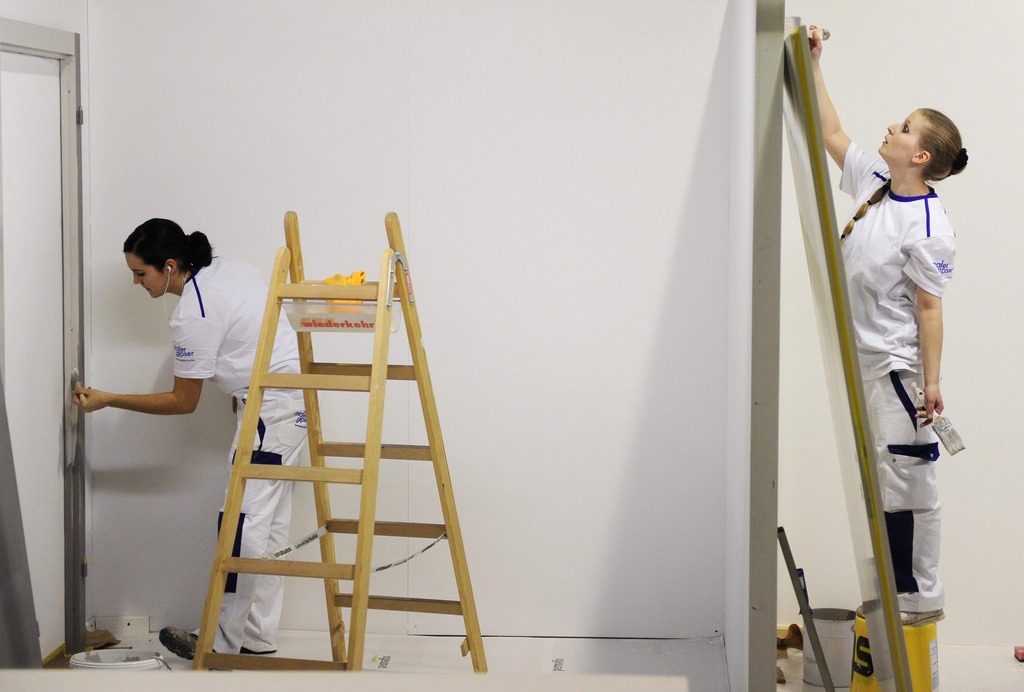Employers face first-ever apprentice shortage

For the first time ever it’s an applicants’ market in the exemplary Swiss apprenticeship system. This year apprenticeship places outnumber school leavers by 4,000.
The surplus is mainly seen in German-speaking Switzerland. Low-scoring students continue to find it hard to find a position but it’s still a major turnaround.
A decade ago there was a shortage of apprenticeship places in Switzerland. “The situation has clearly eased,” Bern’s director of education Bernhard Pulver told a media briefing on the apprentice market.
According to the apprenticeship barometer compiled in April by the Federal Professional Education and Technology Office, Swiss companies were advertising 81,000 apprenticeships in early 2011. That’s 5,000 more than the previous year. But just 77,000 Swiss school leavers are searching for an apprenticeship this year.
“Eight years ago we had to persuade companies to train young people. Now the situation has reversed and that brings big worries for us,” federal office director Ursula Renold said.
In the future it will be increasingly difficult to fill demanding apprenticeships, Renold fears. Young people are currently most interested in apprenticeships in the service sector, in printing, design and applied arts, as well as in health, social services and sales.
Challenging times
In the more demanding technical trades supply of places exceeds demand, the barometer indicates. “Companies are having difficulty finding well-qualified young people for their apprenticeships,” Pulver said.
Demography also plays a role with the number of apprenticeships going up on the one hand and the number of school leavers decreasing on the other. “The demographic dip is fully established,” said Hans-Ulrich Bigler, director of the Swiss Small Firms Association.
“Statistics show that in 2017, 11 per cent fewer young people will be leaving school compared with 2010 and 16 per cent fewer of them will do an apprenticeship”.
Bigler therefore fears recruitment wars for the best candidates and he suggests limiting the proportion of students sitting the pre-university “matura” exam to 24 per cent: “It makes no sense when young people simply opt for an academic education on prestige and other grounds only to end up in a profession with no jobs.”
Small and medium-sized enterprises also need people from a practical background to promote into leading positions, people who have done an apprenticeship followed by higher education.
Regional difference
In contrast to German-speaking Switzerland, the situation is different in the French-speaking part of the country, according to Neuchâtel director of education Philippe Guaego. Here the number of young people who undertake a so-called dual apprenticeship (see right), a practical apprenticeship in a company in parallel with theoretical study at a vocational school, is much lower.
This is because after compulsory schooling there are more full-time places in vocational colleges available than apprenticeships.
“This definitely has to change. The state has to foster the dual system,” Gnaegi said, calling for the public and state-funded sector to implement an apprenticeship quota of four per cent of personnel.
In this way canton Neuchâtel wants to increase the number of apprenticeships annually from 900 in 2006 to 1,500 in 2016. “Employers in the health sector in particular have to open their doors to apprentices,” Gnaegi said.
Weak students
Students with poor school results are in a difficult situation throughout the country. They often either cannot find an apprenticeship or drop out if they start one.
“Specific offerings for young people with learning weaknesses, with social deficiencies and with an immigrant background must be built up,” Pulver said.
Most cantons have introduced a national case management programme designed to target this group. It includes various measures to enable young people with difficulties to get into a trade.
The young people are offered targeted preparation for an apprenticeship, coaching or work experience. “Often it is not just about accompanying the young person but also giving the employer the confidence to take the apprentice on,” Pulver said.
Then it is a question of not letting the young person slip onto the unemployment track but to keep them going with training offers for as long as possible.
Parallel society
And yet there are more and more young people who go straight to the dole queue and end up relying on social security long term, according to Otto Ineichen, parliamentarian and president of the Speranza Association which works for the integration of young people into the work place.
Ineichen estimates that some 25,000 youths between 18 and 25 live on social security, “among them in particular recognised refugees, a growing parallel society”. He sees it as a social time bomb.
Federal office director Renold does not doubt the figure of 25,000 but she cannot confirm it.
A Swiss-wide calculation of the number of people transferred from unemployment benefit to social assistance is difficult: “There are no official statistics on this because social welfare payments are administered by the local communities.”
About two-thirds of 16-21 year-olds opt for vocational training, which combines practice and theory.
The vast majority of such courses last 3 or 4 years, depending on the chosen field, and operate under the day release system. This means the trainee spends most of his or her time working for an approved company but attends a vocational school for 1-2 days per week. Students have a choice of about 300 recognised apprenticeship categories.
Apprentices who pass the final exam at the end of their basic training are awarded a federal diploma which is recognised throughout the country.
Former apprentices can also follow an exam route through which they can gain admission to universities of applied sciences.
Source: swissworld.org
(Translated from German by Clare O’Dea)

In compliance with the JTI standards
More: SWI swissinfo.ch certified by the Journalism Trust Initiative




You can find an overview of ongoing debates with our journalists here. Please join us!
If you want to start a conversation about a topic raised in this article or want to report factual errors, email us at english@swissinfo.ch.